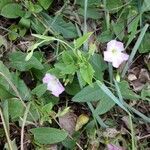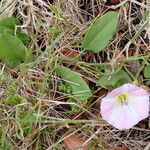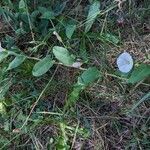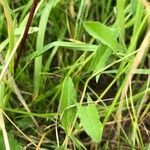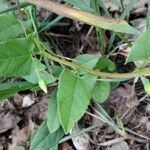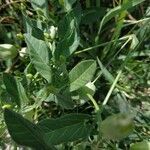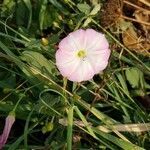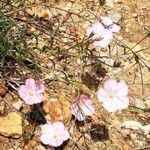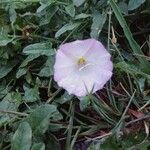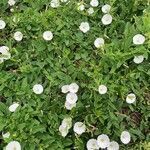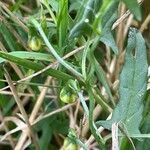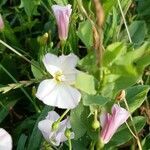Herbs perennial, with ± woody rhizomes. Stems prostrate or twining, to 1 m tall, glabrous or sparsely pubescent. Petiole 0.3-2 cm; leaf blade ovate-oblong to ovate, 1.5-5 X 1-4 cm, glabrous or pubescent, base hastate, sagittate, or cordate, apex obtuse, mucronulate; prominently 3-veined basally, upper parts pinnately veined. Inflorescences axillary, cymose, 1-3-flowered; peduncle 3-8 cm; bracts 2, linear, ca. 3 mm. Pedicel ca. 4 as long as calyx. Sepals unequal, 3.5-5 mm; outer 2 broadly oblong to obovate, shorter, abaxially sparsely pubescent or glabrous, margin ± ciliate, apex retuse; inner ones ovate-circular, margin membranous, apex obtuse or retuse. Corolla white or pink, broadly funnelform, 1.5-2.6 cm, midpetaline bands pubescent outside distally; limb shallowly 5-lobed. Stamens included, unequal; filaments minutely scaly basally. Disc cupular. Ovary ovoid, glabrous or sparsely pubescent. Stigmas cylindric. Capsule ovoid to subglobose, 5-8 mm, glabrous. Seeds 4 or fewer, dark brown or black, ovoid, 3-4 mm, tuberculate. Fl. Jun-Aug, fr. Jun-Sep. 2n = 24, 48, 50.
A perennial herb. Stems prostrate or twining, glabrous or sparsely pubescent. Leaves ovate-oblong to lanceolate, 1½-5 by 1-3 cm, mostly hastate or sagittate at the base, obtuse and mucronulate at the apex, often more or less secund; petiole shorter than the blade. Peduncles axillary, 1-or sometimes 2-3-to more-flowered, shorter to longer than the leaves. Pedicels much longer than the calyx. Bracts linear, ca 3 mm long. Sepals 3½-5 mm long, slightly unequal, 2 outer ones a little shorter, oblong-elliptic, obtuse, shortly ciliate; inner ones nearly orbicular, obtuse or slightly retuse, more or less distinctly mucronu-late. Corolla broadly funnel-shaped, ca 2 cm long, white or pink, or white with pink or red midpetal-ine bands, or pink with red or white midpetaline bands. Stamens slightly unequal, filaments with a broadened base, papillose at the margins. Ovary glabrous. Capsule ovoid-globose, 5-8 mm long, glabrous. Seeds 4, dark brown or black, 3-4 mm long.
Rhizomatous perennial with slender, creeping or trailing, angular, usually hairy stems. Petioles 5-20-(35) mm long. Lamina (0.8)-2-4-(9) × (0.5)-1-2-(6) cm, triangular or oblong-ovate (very rarely linear), hastate or sagittate, entire, except often for pair of teeth near base, usually glabrous or sparsely hairy, rarely moderately hairy, often glaucous; sinus shallow or base ± truncate; apex rounded and mucronulate. Infl. axillary, 1-few-flowered; peduncles often = or slightly > lvs; pedicels slender, glabrous. Bracts 2-4 mm long, linear, hairy, situated > 1 cm below calyx. Sepals c. 4 mm long, obtuse, the outer ciliate and often hairy, subequal. Corolla (1.2)-1.5-2 cm long, broadly funnelform, pink or whitish, with deep pink mid-petaline bands, very rarely completely white. Stamens subequal; filaments widened and puberulent towards base. Stigmas filiform, much < style. Capsule 6-8 mm long, globose-ovoid. Seed dark, smooth.
A vigorous slender climber. It has a woody base and keeps growing from year to year. It has long branched underground stems or rhizomes. These can be 9 m deep. The stems are fine and twining. They have fine hairs when young. The leaves are alternate and broadly oval. They are 3-5 cm long by 1-4 cm wide. The leaves have stalks. They have lobes at the base. The flowers are small and white or pink. They occur singly. They are 2.5 cm across. The flowering stems are in the axils of leaves and are larger than the leaves. Plants sucker freely. The fruit capsules are cone shaped.
Aggressive perennial from deep-seated spreading roots; trailing or climbing to 1 m, often forming tangled mats; lvs variable, triangular to oblong in outline, 1–5 cm, the basal lobes spreading or descending; peduncles axillary, exceeding the subtending lvs, 1–2-fld; bracts subulate to ovate, 1–10 mm, inserted 5–20 mm below the fl; sep elliptic to subrotund, 3–5 mm; cor white or pink, 15–25 mm; 2n=48, 50. Native of Europe, now a common weed in fields, roadsides, and waste places in the U.S. and s. Can. May–Sept. (Strophocaulos a.; C. ambigens, a hairy form)
Perennial herb; stems prostrate or twining, glabrous or pubescent.. Leaf-blade glabrescent, ovate-oblong to lanceolate, 1.5–7.5 cm. long, 1–3 cm. wide, obtuse or mucronulate at the apex, hastate or sagittate at the base; petiole 0.5–2 cm. long.. Peduncle 1(–2–3)-flowered, 2–4 cm. long; bracts linear, about 3 mm. long.. Sepals elliptic-orbicular or oblong, 3.5–5 mm. long, 2–3.5 mm. wide.. Corolla white or pink or both, broadly funnel-shaped, about 2 cm. long.. Capsule glabrous, ovoid-globose, 5–8 mm. long, 4-seeded.. Seeds dark brown or black, 3–4 mm. long.
Perennial herb, with long taproot and annual stems. Stems prostrate or twining, up to 1.75 m long, pubescent to glabrous. Leaves often secund, entire, ± oblong, base hastate-sagittate, 20-50 mm long; petioles shorter than blades. Flowers axillary, mostly solitary; bracteoles linear, ± 3 mm long; pedicel longer than calyx. Sepals 3.5-5.0 mm long. Corolla white or pink, broadly funnel-shaped, glabrous, 15-25 mm long. Flowering time Oct.-Mar. Fruit an ovoid-globose capsule, 5-8 mm long. Seeds 4, dark brown or black, 3-4 mm long.
Perennial herb. Stems procumbent or twining, sparsely pubescent to glabrous. Leaves with blade ovate-oblong or oblong, 20-50 mm long, base hastate or sagittate, apex obtuse, mucronate, margins entire. Flowers: solitary or sometimes in 2-or 3-flowered cymes; calyx lobes elliptic-oblong to almost orbicular, apices obtuse, mucronate; corolla 4-5 x as long as calyx, ± 20 mm long, white with pink or red midpetaline bands or pink; Oct.-Mar. Fruit an ovoid-globose, glabrous capsule, 5-8 mm long.
Poisonous and medicinal perennial herb, with annual, prostrate or twining, glabrous to thinly hairy stems, up to 1.75 m tall, with a long taproot. Leaves entire, hastate or sagittate, up to 50 mm long. Flowers usually solitary in leaf axils, sepals obtuse, up to 5 mm long, corolla funnel-shaped, 15-25 mm long, white to pink, midpetaline areas sometimes dark pink.
Prostrate or twining perennial herb. Leaves ovate-oblong or oblong, with hastate or sagitate base. Flowers solitary or sometimes in 2-or 3-flowered cymes. Corolla ± 20 mm long. Flowers white or pink.
Leaf lamina entire, ovate-oblong or oblong, 1·5–4·5 × 0·5–1·5 cm., with a hastate or sagittate base, obtuse or mucronulate at the apex, glabrous or thinly hairy; petiole 5–10 mm. long.
Thinly hairy, prostrate or climbing perennial with annual stems to 2 m. Leaves hastate. Flowers pink, sepals obtuse, 3.5-5.0 mm long, corolla 15-25 mm long.
Corolla white or pink or both, broadly funnel-shaped, about 2 cm. long in the limb shallowly lobed, glabrous except at apices of the midpetaline areas.
Flowers axillary, solitary or sometimes 2–3 flowered cymes; peduncles 1–1·5 cm.; bracts linear, about 2 mm. long; pedicels up to 10 mm. long.
Perennial herb forming several to many annual stems from a long taproot.
Sepals slightly unequal, elliptic-circular or oblong, 3.5–5 mm. long.
Stems prostrate or twining, angular, sparsely pubescent to glabrous.
Capsule ovoid-globose, glabrous, 4-seeded.
Seeds dark brown or black.
